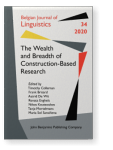The issue of specifying slots in argument structure constructions in terms of form and meaning
In Construction Grammar theory, constructions are generally described as form-meaning pairings. It will be argued
here that the formal specifications of some abstract constructions are so vague that the notion of form needs to be discussed
rather critically. We aim to demonstrate how, in the English predicative and intransitive-motion constructions, the slots of more
general constructions can be seen as being specified indirectly through sets of mini-constructions.
Article outline
- 1.Form and meaning
- 2.The concept of form
- 2.1Subject and object as formal categories
- 2.2Obliques and resultative phrases
- 2.3Underspecification of form
- 3.The English predicative construction
- 4.The form side of the English intransitive-motion construction
- 5.Form of constructions
- Notes
-
References
References (40)
References
Beckner, Clay, Richard Blythe, Joan Bybee, Morton H. Christiansen, William Croft, Nick C. Ellis, John Holland, Jinyun Ke, Diane Larsen-Freeman, and Tom Schoenemann. 2009. “Language is a Complex Adaptive System: Position Paper.” Language Learning 591: 1–26. 

Behrens, Heike. 2011. “Grammatik und Lexikon im Spracherwerb: Konstruktionsprozesse.” In Sprachliches Wissen zwischen Lexikon und Grammatik, ed. by Stefan Engelberg, Anke Holler, and Kristel Proost, 375–396. Berlin/Boston: de Gruyter. 

Boas, Hans C. 2003. A Constructional Approach to Resultatives. Stanford: CSLI Publications.
Boas, Hans C. 2005. “Determining the Productivity of Resultative Constructions: A Reply to Goldberg & Jackendoff.” Language 81(2): 448–464. 

Boas, Hans C. 2011. “Zum Abstraktionsgrad von Resultativkonstruktionen.” In Sprachliches Wissen zwischen Lexikon und Grammatik, ed. by Stefan Engelberg, Kristel Proost, and Anke Holler, 37–69. Berlin/New York: Mouton de Gruyter. 

Bußmann, Hadumod. 2008. Lexikon der Sprachwissenschaft. 4th edn. Stuttgart: Kröner.
Bybee, Joan. 2010. Language, Usage and Cognition. Cambridge: Cambridge University Press. 

Croft, William. 2012. Verbs: Aspect and Causal Structure. Oxford: Oxford University Press. 

Davies, Mark. 2008–. The Corpus of Contemporary American English (COCA). Available online at [URL]
Dürscheid, Christa. 2013. “Casus obliquus.” Wörterbücher zur Sprach- und Kommunikationswissenschaft (WSK) Online (2013). Berlin/Boston: De Gruyter. [URL] (Last accessed 29 August, 2020).
Faulhaber, Susen. 2011. Verb Valency Patterns: A Challenge for Semantics-Based Accounts. Berlin/New York: de Gruyter Mouton. 

Fillmore, Charles J. 1968. “The Case for Case.” In Universals in Linguistic Theory, ed. by Emmon Bach, and Robert T. Harms, 0–88. New York: Holt, Rinehart & Winston.
Fillmore, Charles J. 2007. “Valency Issues in FrameNet.” In Valency: Theoretical, Descriptive and Cognitive Issues, ed. by Thomas Herbst, and Katrin Götz-Votteler, 129–160. Berlin/New York: Mouton de Gruyter.
Fillmore, Charles J. 2014. “Frames, Constructions and FrameNet.” In Constructions – Collocations – Patterns, ed. by Thomas Herbst, Hans-Jörg Schmid, and Susen Faulhaber, 121–166. Berlin/Boston: de Gruyter Mouton. 

Goldberg, Adele E. 1995. Constructions: A Construction Grammar Approach to Argument Structure. Chicago: Chicago University Press.
Goldberg, Adele E. 2006. Constructions at Work: The Nature of Generalization in Language. Oxford/New York: Oxford University Press.
Goldberg, Adele E. 2019. Explain Me This: Creativity, Competition, and the Partial Productivity of Constructions. Princeton/Oxford: Princeton University Press.
Goldberg, Adele E., and Ray Jackendoff. 2004. “The English Resultative as a Family of Constructions.” Language 80(3): 532–568. 

Haugen, Tor Arne. 2012. Polyvalent Adjectives in Norwegian: Aspects of their Semantics and Complementation Patterns. Oslo: University of Oslo.
Helbig, Gerhard, and Wolfgang Schenkel. 1973. Wörterbuch zur Valenz und Distribution deutscher Verben. Leipzig: Verlag Enzyklopädie.
Herbst, Thomas. 2011. “The Status of Generalizations: Valency and Argument Structure Constructions.” Zeitschrift für Anglistik und Amerikanistik 59(4): 347–367. 

Herbst, Thomas. 2014. “The Valency Approach to Argument Structure Constructions.” In Constructions – Collocations – Patterns, ed. by Thomas Herbst, Hans-Jörg Schmid, and Susen Faulhaber, 167–216. Berlin/Boston: de Gruyter Mouton. 

Herbst, Thomas. 2016. “Foreign Language Learning is Construction Learning – what else? Moving towards Pedagogical Construction
Grammar.” In Applied Construction Grammar, ed. by Sabine de Knop, and Gaëtanelle Gilquin, 21–51. Berlin/Boston: De Gruyter Mouton. 

Herbst, Thomas, David Heath, Ian F. Roe, and Dieter Götz. 2004. A Valency Dictionary of English. London/New York: Mouton de Gruyter. 

Herbst, Thomas, and Thomas Hoffmann. 2018. “Construction Grammar for Students: A Constructionist Approach to Syntactic Analysis (CASA).” Yearbook of the German Cognitive Linguistics Association 61: 197–218. 

Herbst, Thomas, and Susen Schüller. 2008. Introduction to Syntactic Analysis: A Valency Approach. Tübingen: Narr.
Hilpert, Martin. 2020. “Constructional Approaches.” In The Oxford Handbook of English Grammar, ed. by Bas Aarts, Jill Bowie, and Gergana Popova, 106–123. Oxford/New York: Oxford University Press.
Hoffmann, Thomas. 2015. “Cognitive Sociolinguistic Aspects of Football Chants: the Role of Social and Physical Context in Usage-Based
Construction Grammar.” Zeitschrift für Anglistik und Amerikanistik 66(3): 273–294. 

Huddleston, Rodney, and Geoffrey K. Pullum. 2002. The Cambridge Grammar of the English Language. Cambridge: Cambridge University Press. 

Langacker, Ronald W. 2008. Cognitive Grammar: A Basic Introduction. Oxford/New York: Oxford University Press. 

Quirk, Randolph, Sidney Greenbaum, Geoffrey Leech, and Jan Svartvik. 1985. A Comprehensive Grammar of the English Language. London/New York: Longman.
Saussure, Ferdinand de. 1916. Cours de linguistique générale (Ed. by Charles Bally & Albert Séchehaye). Lausanne: Payot.
Schmid, Hans-Jörg. 2000. English Abstract Nouns as Conceptual Shells: From Corpus to Cognition. Berlin/New York: Mouton de Gruyter. 

Schmid, Hans-Jörg. 2020. The Dynamics of the Linguistic System: Usage, Conventionalization and Entrenchment. Oxford: Oxford University Press. 

Schumacher, Helmut, Jacqueline Kubczak, Renate Schmidt, and Vera de Ruiter. 2004.
valbu – Valenzwörterbuch deutscher Verben. Tübingen: Narr.
Uhrig, Peter. 2018. Subjects in English: From Valency Grammar to a Constructionist Treatment of Non-Canonical Subjects. Berlin/Boston: de Gruyter. 

Cited by (2)
Cited by two other publications
Gonzálvez-García, Francisco
Ungerer, Tobias & Stefan Hartmann
2023.
Constructionist Approaches,

This list is based on CrossRef data as of 4 july 2024. Please note that it may not be complete. Sources presented here have been supplied by the respective publishers.
Any errors therein should be reported to them.
